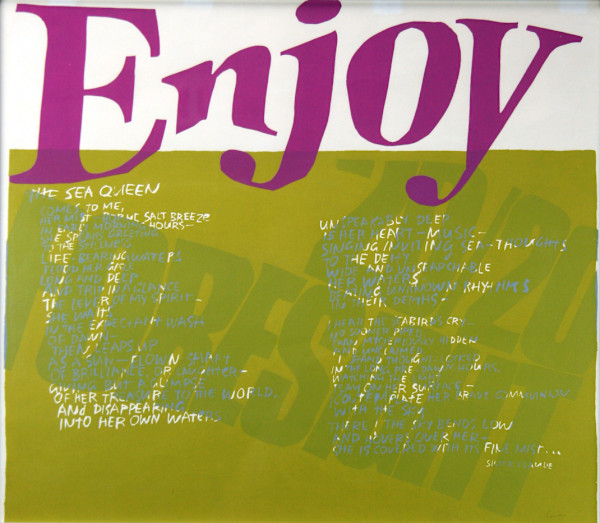
-
Artist: Corita Kent (American, 1918-1986)
Corita Kent (1918–1986), also known as Sister Mary Corita, was an American artist, educator, and social justice advocate known for her vibrant and thought-provoking screen prints. She was a member of the Roman Catholic order of the Immaculate Heart of Mary in Los Angeles, where she taught art for many years. Her work blended elements of Pop Art, spirituality, and activism, making her an important figure in both the art world and progressive Catholic circles during the 1960s and 1970s.
Early Life and Religious Background:
Born: Frances Elizabeth Kent, November 20, 1918, in Fort Dodge, Iowa.
Joined the Sisterhood: In 1936, she entered the order of the Sisters of the Immaculate Heart of Mary, and it was during this time that she took the name Sister Mary Corita.
Corita Kent earned her BA from Immaculate Heart College and later a master’s degree from the University of Southern California.
Art and Teaching Career:
Immaculate Heart College: Kent became the head of the art department at Immaculate Heart College in Los Angeles, where she taught from the 1940s until 1968. Under her direction, the art department became a center of creative innovation, attracting prominent artists and fostering a socially aware and experimental environment.
Artistic Style and Themes:
Screen Printing: Corita Kent is best known for her screen prints, using bold colors, expressive typography, and collaged elements from advertising, street signs, and packaging. Her work often included uplifting messages, combining scripture, popular culture, and calls for social justice.
Pop Art Influence: Like her Pop Art contemporaries such as Andy Warhol and Robert Indiana, Kent used mass media and commercial imagery. However, her focus was on humanistic and spiritual messages rather than consumerism and celebrity.
Social Justice: Much of Kent’s work in the 1960s reflected her growing commitment to peace, civil rights, and anti-war activism. She often used her art to address pressing social issues, particularly during the Vietnam War. For example, her famous piece "Stop the Bombing" called for an end to U.S. military involvement in Vietnam.
Typography: A distinctive feature of Kent's work was her use of vibrant text. She would mix fonts and overlay text, often including messages of love, hope, and faith, quoting from sources as varied as the Bible, poets like E.E. Cummings, and popular slogans.
Departure from Religious Life:
In 1968, amid increasing tensions between the Vatican and progressive nuns advocating for reforms, Corita Kent left the religious order. She moved to Boston, where she continued her work as an artist until her death in 1986.
Legacy and Influence:
Corita Kent's work continues to inspire artists, activists, and educators. She is often celebrated for her joyful, optimistic art that blended political activism with a deep sense of spirituality.
Her art is housed in numerous prominent collections, including the Los Angeles County Museum of Art (LACMA) and the Museum of Modern Art (MoMA) in New York.
Kent also designed the well-known 1985 "Love" postage stamp, which became one of the most popular stamps ever issued by the U.S. Postal Service.
Impact:
Corita Kent's legacy is that of an artist who used her platform and creativity to advocate for a more just and compassionate world. Her art serves as a reminder of the power of creativity in the pursuit of social change and the blending of faith and activism.
Her work has been the subject of retrospectives and exhibitions in recent years, highlighting her as a significant figure in both the art world and the broader movements for peace and justice during her lifetime.
Powered by Artwork Archive

